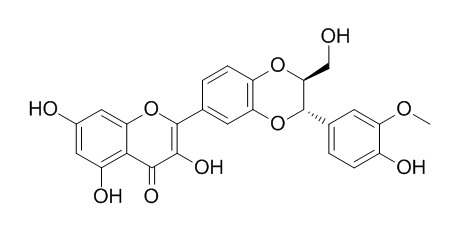2,3-Dehydrosilybin B
2,3-Dehydrosilybin B inhibits Aβ aggregation.
Inquire / Order:
manager@chemfaces.com
Technical Inquiries:
service@chemfaces.com
Tel:
+86-27-84237783
Fax:
+86-27-84254680
Address:
1 Building, No. 83, CheCheng Rd., Wuhan Economic and Technological Development Zone, Wuhan, Hubei 430056, PRC
Providing storage is as stated on the product vial and the vial is kept tightly sealed, the product can be stored for up to
24 months(2-8C).
Wherever possible, you should prepare and use solutions on the same day. However, if you need to make up stock solutions in advance, we recommend that you store the solution as aliquots in tightly sealed vials at -20C. Generally, these will be useable for up to two weeks. Before use, and prior to opening the vial we recommend that you allow your product to equilibrate to room temperature for at least 1 hour.
Need more advice on solubility, usage and handling? Please email to: service@chemfaces.com
The packaging of the product may have turned upside down during transportation, resulting in the natural compounds adhering to the neck or cap of the vial. take the vial out of its packaging and gently shake to let the compounds fall to the bottom of the vial. for liquid products, centrifuge at 200-500 RPM to gather the liquid at the bottom of the vial. try to avoid loss or contamination during handling.
Plants (Basel).2021, 10(4):702.
Pharmaceuticals (Basel).2021, 14(7):633.
Molecules.2024, 29(5):1048.
Phytomedicine.2021, 2(82):153452
J Sep Sci.2021, 44(22):4064-4081.
Food Chem.2022, 373(Pt B):131364.
Patanjali Research Foundation2024, ssrn.4807357
Pharmaceuticals (Basel).2024, 17(6):727.
Fitoterapia.2015, 100:179-86
Int J Nanomedicine.2022, 17:6513-6525.
Related and Featured Products
ACS Chemical Neuroscience, 09 Jun 2017, 8(8):1767-1778.
Inhibition of Aβ Amyloid Growth and Toxicity by Silybins: The Crucial Role of Stereochemistry.[Reference:
WebLink]
The self-assembling of the amyloid β (Aβ) peptide into neurotoxic aggregates is considered a central event in the pathogenesis of Alzheimer's disease (AD). Based on the "amyloid hypothesis", many efforts have been devoted to designing molecules able to halt disease progression by inhibiting Aβ self-assembly.
METHODS AND RESULTS:
Here, we combine biophysical (ThT assays, TEM and AFM imaging), biochemical (WB and ESI-MS), and computational (all-atom molecular dynamics) techniques to investigate the capacity of four optically pure components of the natural product silymarin (silybin A, silybin B, 2,3-dehydrosilybin A, 2,3-Dehydrosilybin B) to inhibit Aβ aggregation. Despite TEM analysis demonstrated that all the four investigated flavonoids prevent the formation of mature fibrils, ThT assays, WB and AFM investigations showed that only silybin B was able to halt the growth of small-sized protofibrils thus promoting the formation of large, amorphous aggregates. Molecular dynamics (MD) simulations indicated that silybin B interacts mainly with the C-terminal hydrophobic segment 35MVGGVV40 of Aβ40. Consequently to silybin B binding, the peptide conformation remains predominantly unstructured along all the simulations. By contrast, silybin A interacts preferentially with the segments 17LVFF20 and 27NKGAII32 of Aβ40 which shows a high tendency to form bend, turn, and β-sheet conformation in and around these two domains. Both 2,3-dehydrosilybin enantiomers bind preferentially the segment 17LVFF20 but lead to the formation of different small-sized, ThT-positive Aβ aggregates. Finally, in vivo studies in a transgenic Caenorhabditis elegans strain expressing human Aβ indicated that silybin B is the most effective of the four compounds in counteracting Aβ proteotoxicity.
CONCLUSIONS:
This study underscores the pivotal role of stereochemistry in determining the neuroprotective potential of silybins and points to silybin B as a promising lead compound for further development in anti-AD therapeutics.
Tetrahedron Letters, 2013, 54(46):6279-6282.
Microwave-assisted oxidation of silibinin: a simple and preparative method for the synthesis of improved radical scavengers.[Reference:
WebLink]
A new and preparative oxidation of silibinin has been developed to give access to two different silibinin derivatives known for their enhanced antioxidant properties.
METHODS AND RESULTS:
Conventional heating methods were compared with results obtained from microwave (MW) heating. The base-catalysed oxidation of silibinin under MW heating is a very efficient method for the preparation of 2,3-dehydrosilybin and a related silybin rearrangement product. This latter compound shows enhanced radical scavenging properties.
CONCLUSIONS:
Optimised conditions were used to prepare 2,3-dehydrosilybin A and 2,3-Dehydrosilybin B from optically pure silybin A and silybin B.
An efficient, preparative purification method was also developed to enable isolation of different products in high purity.



